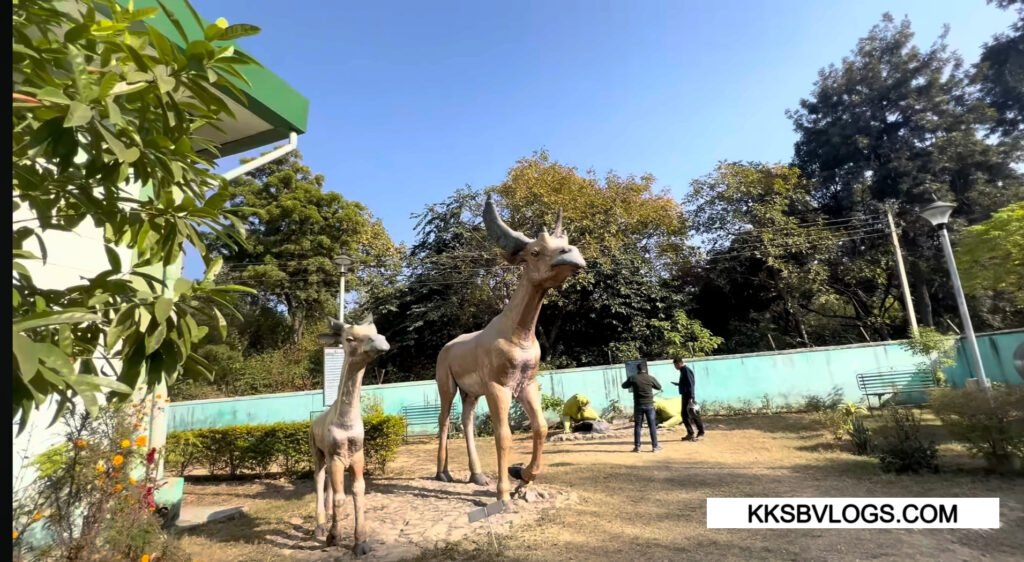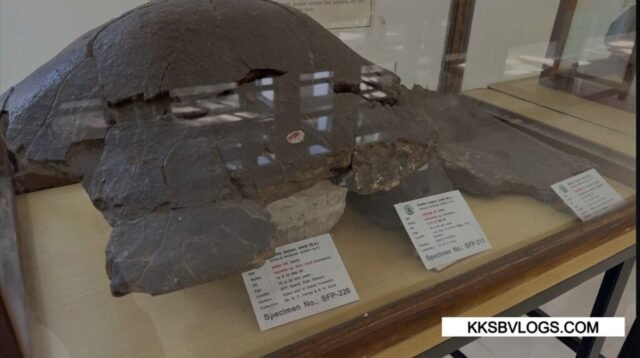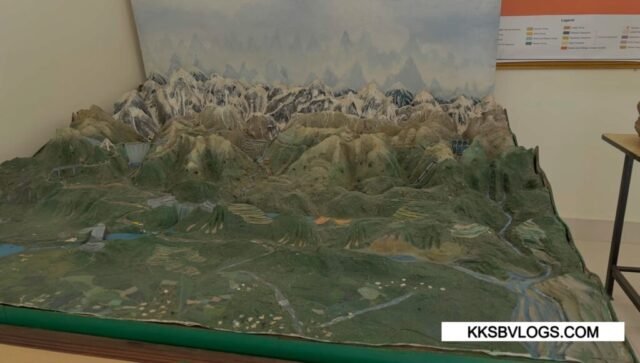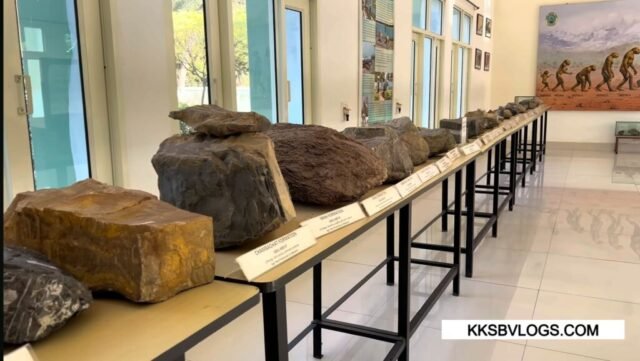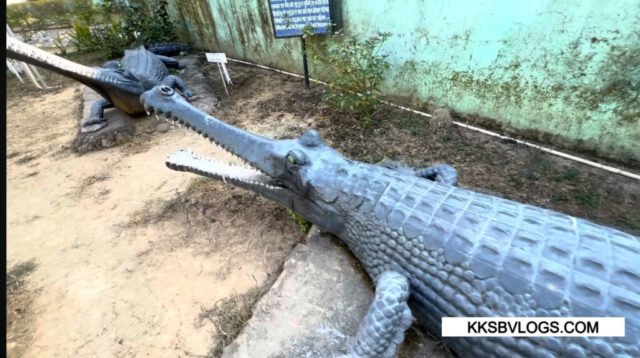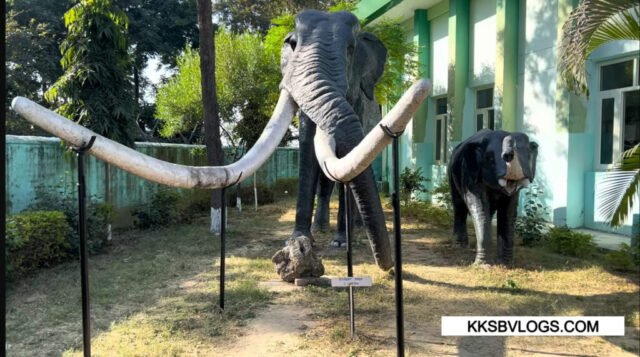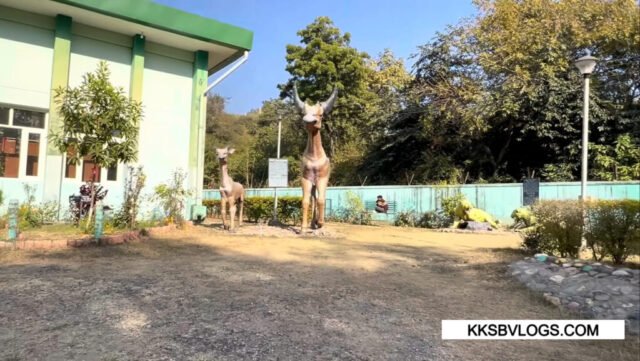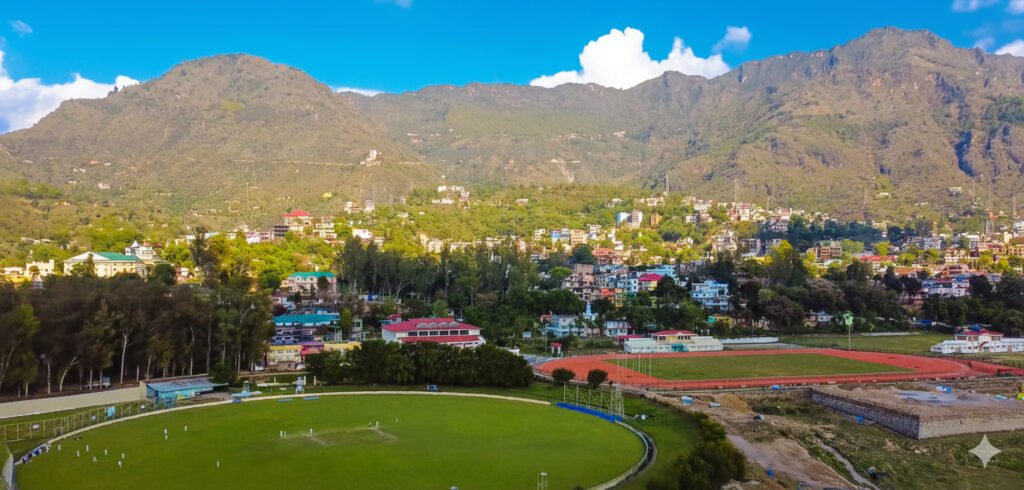1) Introduction
In Himachal Pradesh’s Sirmaur district, about 21 km from Nahan, there lies a natural museum that transports you back millions of years — Suketi Fossil Park.
This is not just Himachal’s pride but Asia’s first fossil park built exactly on an original fossil site.
This means the fossils you see here were found in this very land, not brought from elsewhere.
The park offers a truly unique experience:
- As you enter, you are greeted by life-size fiberglass models of prehistoric giants — Stegodon (ancient elephant), Hipparion horse, giant tortoise, sabre-toothed cat, and even prehistoric crocodiles.
- Inside the fossil museum, authentic bones, jaw fragments, molar teeth, and limb fossils are showcased with scientific explanation boards.
- The lush green Markanda river valley backdrop, the cool breeze of the Shivalik foothills, and the natural silence make this place a rare combination of family picnic + educational trip + photography spot.
This open-air prehistoric classroom is perfect for:
School groups | Geology students | Nature photographers | Weekend travelers
2) History & Discovery of Suketi Fossil Park
The story of Suketi Fossil Park begins in the 19th century with British surveyors.
While conducting geological mapping in the fertile plains of the Markanda river, they noticed strange bone-like rocks.
Their records later inspired Indian palaeontologists to carry out detailed excavations, which confirmed that these were true fossils from the Miocene–Pliocene epoch (around 2.5–5 million years old) preserved in the Siwalik rock formations.
In the 1970s, the Geological Survey of India and the Himachal Pradesh government decided to create an interpretive park right at the original fossil site so that:
- Science students could observe in-situ fossils
- The public could experience India’s ancient wildlife authentically
Thus, in 1974, Suketi Fossil Park was officially established — today a proud milestone of Asian palaeontology.
The fossils here have helped scientists understand:
- What the prehistoric Himalayas looked like
- How climate changes shaped the region
- The evolution of mammals over time
3) Geological & Paleontological Significance
The greatest attraction of Suketi Fossil Park is not just its museum but the millions-of-years-old earth layers beneath it.
This site is part of the Middle & Upper Siwalik formations — sedimentary rocks formed during the uplift of the Himalayas.
The fossils mainly belong to the Miocene–Pliocene epoch, a time when tropical savannas and riverine grasslands spread across North India.
3.1 Prehistoric Giants
Excavations reveal that these mighty animals once roamed here:
- Stegodon – A giant elephant ancestor with 3–4 metre tusks.
- Hipparion horse – A three-toed ancient horse that galloped across open grasslands.
- Giant tortoise – Reptiles with shells up to 2 metres wide, living near swampy riversides.
- Sabre-toothed cats – Fierce predators with long sharp canines, hunting along forest–savanna edges.
- Prehistoric crocodiles & hippopotamus – Evidence of deep rivers and wetlands in this region.
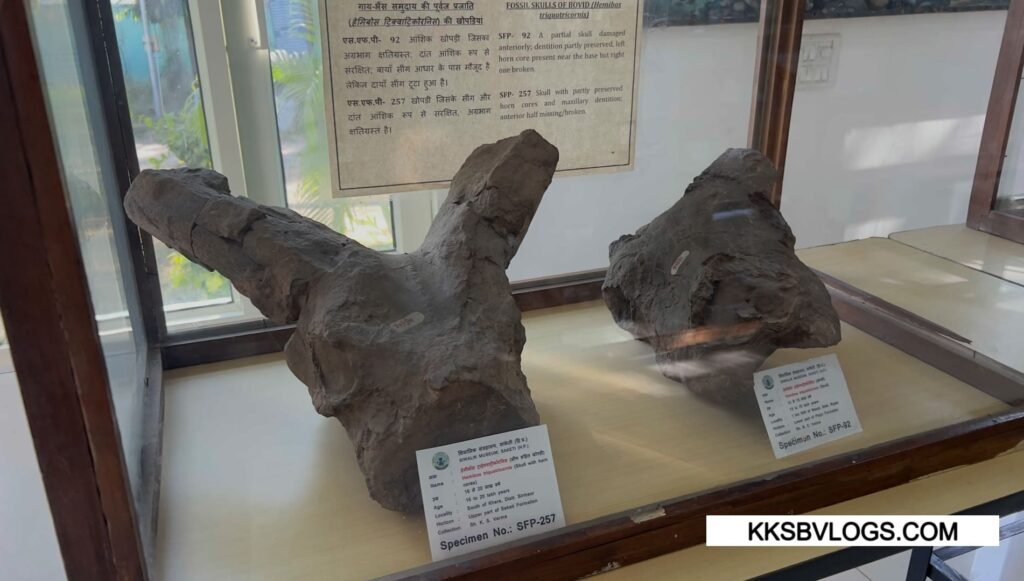
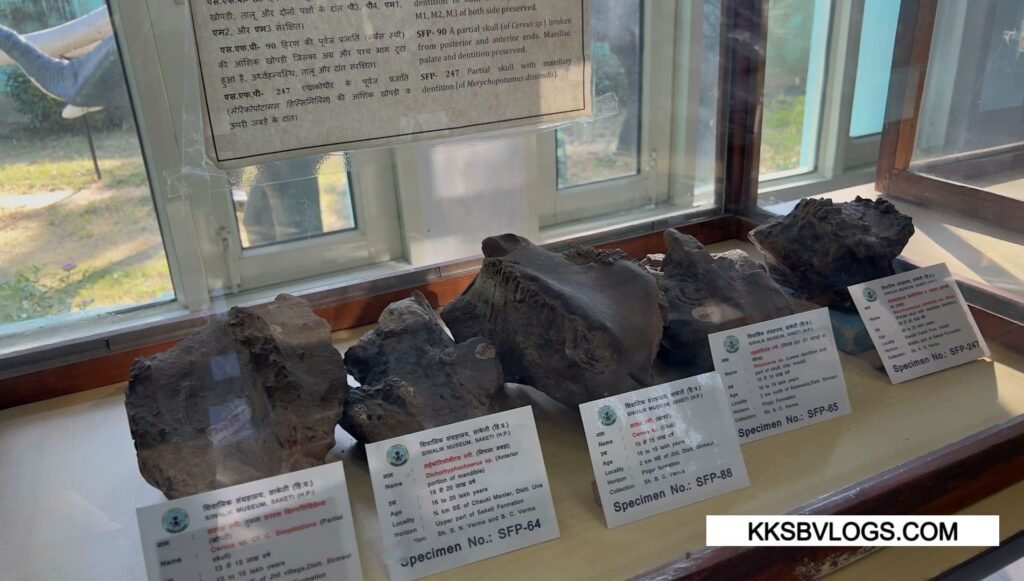
3.2 Earth’s Changing Climate
These fossils give scientists clear proof that millions of years ago the Markanda river valley was warm and humid, gradually turning cool and dry.
As the Himalayas rose and monsoon patterns shifted, these animals went extinct, leaving their remains locked in sandstone layers.
3.3 Scientific Treasure
The preserved bones, jaws, teeth, and limb fossils are priceless for palaeontologists.
They provide crucial insights into:
- Mammalian migration
- Himalayan geology
- Quaternary climate change
That’s why Suketi is often called a natural open-air laboratory for researchers worldwide.

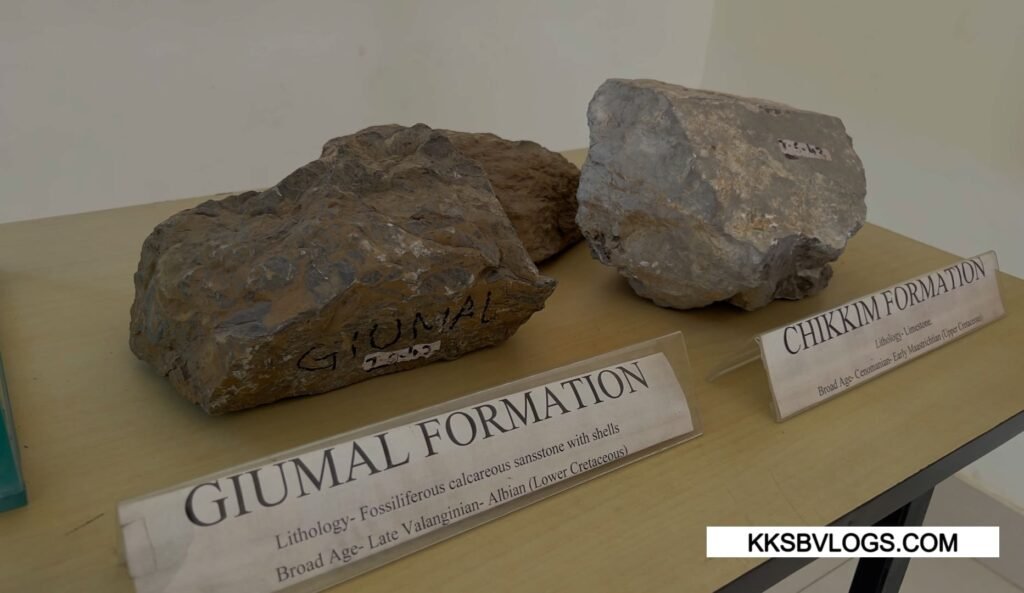
4) Park Layout & Museum Attractions
Entering Suketi Fossil Park feels like stepping into a prehistoric open-air gallery. The park is designed to balance science and leisure, offering something for visitors of all ages.
4.1 Entry Plaza & Interpretation Centre
Just past the gate, the visitor interpretation centre welcomes you with:
- Introductory panels explaining fossil formation, Siwalik geology, and the story of excavations
- Short documentary films giving quick science lessons — perfect for school groups and families
4.2 Life-Size Fiberglass Models
The most eye-catching feature is the life-size animal replicas from 2.5–5 million years ago:
- Stegodon elephant with gigantic 3–4 m tusks
- Hipparion horse with three toes
- Sabre-toothed cat, frozen mid-pounce
- Giant tortoise with an almost 2 m shell
- Prehistoric crocodiles and hippopotamus models, reminders of ancient wetland life
Their realistic poses and landscaped backgrounds make them perfect for photography, and children love the Jurassic-Park style adventure.
4.3 Fossil Museum & Display Halls
The main museum building is climate-controlled, preserving:
- Original fossils, teeth, jaws, limb bones, and vertebrae 🦴
- Glass showcases with detailed labels on age, species, and discovery layers
- Touch-screen panels and magnifying glasses for close observation, giving students the feel of a live science lab 🔬
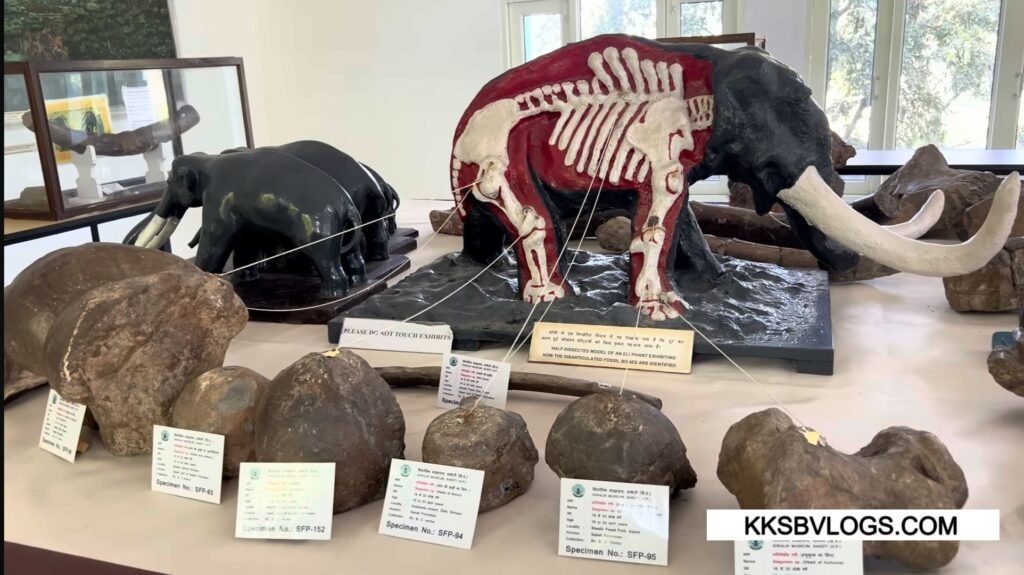
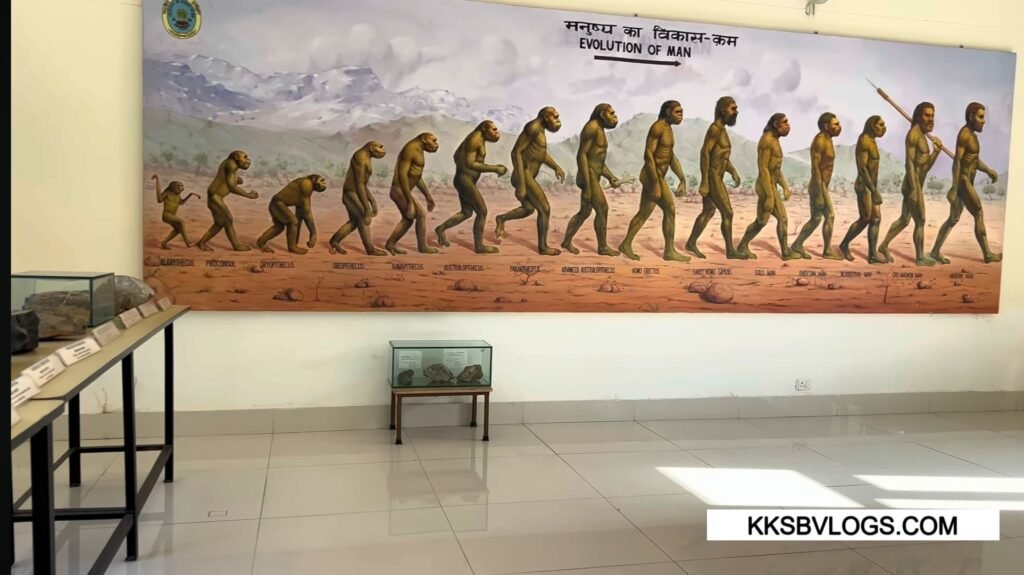
4.4 Nature Trails & Fossil Site Zones
After exploring the museum, natural walking trails guide you to actual excavation points.
Informative signboards explain which fossil layers were discovered where.
The forest sounds of the Shivalik foothills and the cool mountain breeze make this walk peaceful and immersive. 🍃🚶♂️
5) Things to Do & Learn at Suketi Fossil Park
A visit here isn’t just sightseeing — it’s an interactive learning experience.
- Guided Educational Walks: Park guides share stories of the prehistoric era in an engaging style, perfect for school or college groups.
- Photography & Videography: Fiberglass animals and natural backdrops form the perfect DSLR combination.
- Bird & Nature Observation: The Markanda river belt is home to Himalayan bulbuls, drongos, and seasonal migratory birds.
- Family Picnics: Open lawns with benches and shade trees are great for relaxed family gatherings.
- Student Projects & Research: For geology, palaeontology, and environmental science students, this is a live on-field laboratory where real fossils can be studied on-site.
💡 Tips for Visitors
- Wear comfortable walking shoes, carry a hat/sunglasses and a water bottle.
- Photography inside the museum is usually restricted — check rules at the entry gate.
6) Best Time to Visit Suketi Fossil Park
The park is open year-round, but each season provides a unique experience:
Spring & Summer (March–June)
- Pleasant weather around 18–28 °C
- Clear skies and lush greenery — ideal for nature trail walks
- Peak time for school trips
Monsoon (July–September)
- Shivalik hills turn deep green, and light mist creates a dreamy atmosphere 🌿☁️
- Carry a raincoat and non-slip shoes for safety
Autumn & Winter (October–February)
- Crisp post-monsoon air and crystal-clear horizons are perfect for photography 📸
- Comfortable temperatures (8–20 °C)
- Occasional early-morning fog gives the museum a mysterious charm 🌫️
7) Visitor Information
Suketi Fossil Park, Himachal Pradesh is a family-friendly and student-friendly destination where you can enjoy a perfect mix of science, nature, and photography.
Before visiting, keep this practical information in mind:
Timings & Entry Fee
- Park hours: 9:00 AM – 5:00 PM (open all days)
- Entry fee: Nominal — around ₹10–20 for adults and ₹5–10 for children
- Student group discounts are often available
- Photography: Free in the outer model zone, but there may be restrictions inside the museum section
Facilities Available
- Clean washrooms and drinking water points
- Benches and shaded lawns for picnic breaks
- Parking space for cars and buses
- Basic snack stalls near the entrance (best to carry packed food if planning a long stay)
Duration of Visit
- Museum + outdoor models + trails: about 2–3 hours
- School or research groups with guided sessions: up to half a day
Travel Tip
- Wear comfortable shoes, carry a hat/sunglasses, and bring drinking water
- During monsoon, a raincoat and non-slip shoes are essential
- Morning visits are best for peaceful walks and perfect photography
8) How To Reach Suketi Fossil Park
- Suketi Fossil Park = 21 km from Nahan, ~5 km from Kala Amb.
- By Road (best option)
- From Nahan → taxi/local vehicle to Suketi.
- From Chandigarh/Ambala/Yamunanagar → first reach Kala Amb, then taxi/auto to park.
- By Bus → Bus till Nahan or Kala Amb, then taxi/jeep.
👉 Last stretch (Kala Amb → Suketi) needs local taxi/auto.
9) Our Experience At Suketi Fossil Park
Our visit to Suketi Fossil Park in Sirmaur was like stepping into a living textbook where science and nature blend beautifully.
The Journey
Early morning, we started from Nahan, enjoying the fresh air and light mist of the Markanda river’s green belt.
Sunlight filtering through deodar and sal trees set the perfect mood for the day.
The First Glimpse
At the park’s entrance, a huge life-size Stegodon elephant model greeted us — a true time-travel moment.
The excitement of the children was unmatched; for them, the area felt like a giant outdoor dinosaur movie. 🎬
Exploring the Giants
Walking further, we admired Hipparion horse, sabre-toothed cat, and giant tortoise fiberglass models.
Each model had informative boards explaining how these creatures roamed the Markanda valley millions of years ago.
Inside the Museum
The feeling grew more intense as we entered the fossil museum.
Looking at original fossil bones, teeth, jaws, and vertebrae behind glass cases, it was awe-inspiring to imagine these beings once walking the earth.
A knowledgeable guide explained how, during the Miocene-Pliocene epoch, the Himalayas gradually rose and climate change led to their extinction.
Nature Trail Walk
Later, we enjoyed a nature trail walk to actual excavation points.
Surrounded by dense greenery and birdsong, and reading scientific notes on signboards, it felt like attending a silent outdoor classroom.
Photography & Relaxation
For photography lovers, the trail was perfect — fiberglass animals with natural backdrops created postcard-worthy frames.
We ended the day with a picnic on the lawns, relaxing on benches while enjoying serene views of the Markanda river valley.
The cool mountain breeze and forest silence refreshed us completely.
Final Thought
For us, Suketi Fossil Park was more than just a fossil site — it was a live history book, where every stone and bone tells a story millions of years old.
10) Nearby Attractions
Around Suketi Fossil Park, you’ll find several unique destinations that make your trip richer — blending heritage, spirituality, and nature.
1. Nahan Town – approx 21 km
The charming district headquarters of Sirmaur, Nahan is known for:
- Heritage architecture
- Rani Tal garden
- Jagannath Temple
- Relaxing Mall Road walks and local Himachali street food
Photography enthusiasts will love the old churches and colonial houses.
2. Renuka Ji Lake & Temple – approx 55 km
- Himachal’s largest natural lake, dedicated to Mata Renuka Ji
- Enjoy boating, a peaceful parikrama walk, and the famous November Renuka fair
- Perfect half-day spiritual and cultural trip after visiting Suketi
3. Gurdwara Paonta Sahib – approx 48 km
- Located along the Yamuna river
- A significant Sikh pilgrimage center connected to Guru Gobind Singh Ji
- Highlights: Heritage museum, daily langar, and peaceful riverfront meditation
4. Jaitak Fort – approx 35 km
- A silent witness to the 1814–16 Anglo–Gurkha war
- From its hilltop location, enjoy a 360° panoramic view of the Nahan valley
- Ideal for a short hike and sunset photography
5. Dhaula Kuan Orchards – approx 25 km
- Famous for litchi, mango, and citrus fruits
- Seasonal fruit shopping and fresh juice tasting add a sweet touch to your trip
These nearby destinations turn your Suketi Fossil Park trip into a balanced experience of science, culture, and spiritual relaxation.
11) Suketi Fossil Park Location, Photos & Videos
Instagram Updates: Stay connected with us for reels and updates– @official_kksb
YouTube Video:Coming soon on – KKSB Vlogs
Suketi Fossil Park Photos
Suketi Fossil Park Location
❓ 10) FAQs about Suketi Fossil Park
Where is Suketi Fossil Park located?
Suketi Fossil Park is in Sirmaur district, Himachal Pradesh, about 21 km from Nahan and around 75 km from Chandigarh, nestled in the scenic Markanda river valley.
Why is Suketi Fossil Park special?
It is Asia’s first fossil park built on an actual fossil site, displaying 2.5–5 million-year-old prehistoric mammal fossils and life-size models of Stegodon, Hipparion horse, sabre-toothed cat, and more.
What are the visiting hours and entry fees?
The park is open daily from 9:00 AM to 5:00 PM.
Entry fees are nominal — about ₹10–20 for adults and ₹5–10 for children, with special discounts for school groups.
What can visitors see inside the park?
Visitors can explore life-size fiberglass animal models, a fossil museum with real bones, jaws, and teeth, interactive panels, and nature trails leading to actual fossil excavation sites.
What is the best time to visit Suketi Fossil Park?
The ideal seasons are March–June (pleasant weather and greenery) and October–February (clear skies for photography).
Monsoon (July–September) brings a lush, misty atmosphere for nature lovers.
How to reach Suketi Fossil Park?
From Nahan, it’s a 40-minute drive.
From Chandigarh, about 3 hours via Kala Amb – Nahan route.
Nearest railway stations: Ambala Cantt and Chandigarh; nearest airport: Chandigarh Airport.
Is Suketi Fossil Park good for families and kids?
Absolutely! The outdoor life-size models thrill kids, while the museum and nature trails provide an educational yet fun family day trip.
Picnic lawns make it even more relaxing.
Which attractions can be visited nearby?
Top nearby spots include Nahan town, Renuka Ji Lake & Temple, Gurdwara Paonta Sahib, Jaitak Fort, and Dhaula Kuan orchards — perfect for a 1–2 day extended itinerary.
✅ Recommended Visiting Window: Morning hours (after sunrise) are best for peaceful walks, bird photography, and guided tours, making your trip refreshing and memorable.

